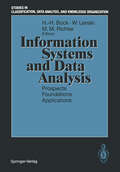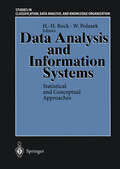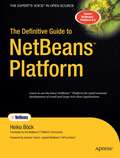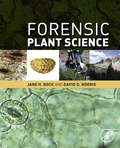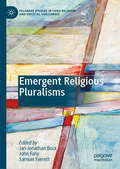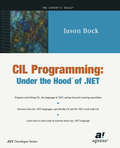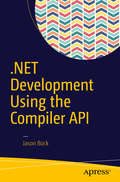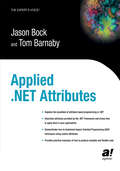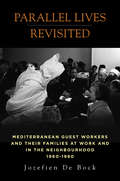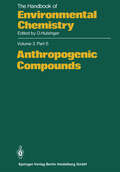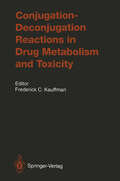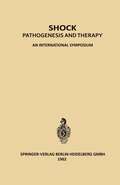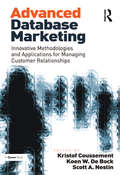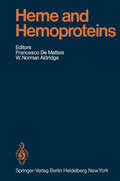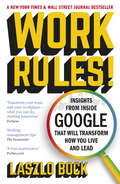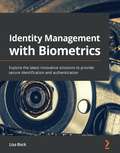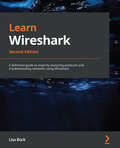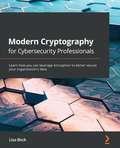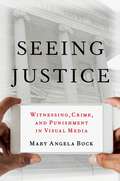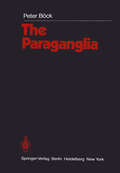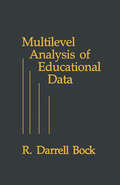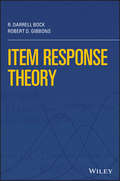- Table View
- List View
Information Systems and Data Analysis: Prospects — Foundations — Applications (Studies in Classification, Data Analysis, and Knowledge Organization)
by Hans Hermann Bock Wolfgang Lenski Michael M. RichterProceedings of the 17th Annual Conference of the Gesellschaft für Klassifikation e.V., University of Kaiserslautern, March 3 - 5, 1993
Data Analysis and Information Systems: Statistical and Conceptual Approaches Proceedings of the 19th Annual Conference of the Gesellschaft für Klassifikation e.V. University of Basel, March 8–10, 1995 (Studies in Classification, Data Analysis, and Knowledge Organization)
by Hans Hermann Bock Wolfgang PolasekThis volume presents 45 articles dealing with theoretical aspects, methodo logical advances and practical applications in domains relating to classifica tion and clustering, statistical and computational data analysis, conceptual or terminological approaches for information systems, and knowledge struc tures for databases. These articles were selected from about 140 papers presented at the 19th Annual Conference of the Gesellschaft fur Klassifika tion, the German Classification Society. The conference was hosted by W. Polasek at the Institute of Statistics and Econometry of the University of 1 Basel (Switzerland) March 8-10, 1995 . The papers are grouped as follows, where the number in parentheses is the number of papers in the chapter. 1. Classification and clustering (8) 2. Uncertainty and fuzziness (5) 3. Methods of data analysis and applications (7) 4. Statistical models and methods (4) 5. Bayesian learning (5) 6. Conceptual classification, knowledge ordering and information systems (12) 7. Linguistics and dialectometry (4). These chapters are interrelated in many respects. The reader may recogni ze, for example, the analogies and distinctions existing among classification principles developed in such different domains as statistics and information sciences, the benefit to be gained by the comparison of conceptual and ma thematical approaches for structuring data and knowledge, and, finally, the wealth of practical applications described in many of the papers. For convenience of the reader, the content of this volume is briefly reviewed.
The Definitive Guide to NetBeans Platform
by Heiko BockThe Definitive Guide to NetBeans™ Platform is a thorough and definitive introduction to the NetBeans Platform, covering all its major application programming interfaces (APIs) in detail, with relevant code examples used throughout. The original German book on which this title is based was well received. The NetBeans platform community has put together this English translation, which author Heiko Böck updated to cover NetBeans platform 6.5 APIs. With an introduction by known NetBeans platform experts Jaroslav Tulach, Tim Boudreau, and Geertjan Wielenga, this is the most up-to-date book on this topic. All NetBeans platform developers will be interested in purchasing it, because several topics in the book have not been documented anywhere else.
Forensic Plant Science
by Jane H Bock David O. NorrisForensic botany is the application of plant science to the resolution of legal questions. A plant’s anatomy and its ecological requirements are in some cases species specific and require taxonomic verification; correct interpretation of botanical evidence can give vital information about a crime scene or a suspect or victim. The use of botanical evidence in legal investigations in North America is relatively recent. The first botanical testimony to be heard in a North American court concerned the kidnapping and murder of Charles Lindbergh’s baby boy and the conviction of Bruno Hauptmann in 1935. Today, forensic botany encompasses numerous subdisciplines of plant science, such as plant anatomy, taxonomy, ecology, palynology, and diatomology, and interfaces with other disciplines, e.g., molecular biology, limnology and oceanography. Forensic Plant Science presents chapters on plant science evidence, plant anatomy, plant taxonomic evidence, plant ecology, case studies for all of the above, as well as the educational pathways for the future of forensic plant science. Provides techniques, collection methods, and analysis of digested plant materials Shows how to identify plants of use for crime scene and associated evidence in criminal cases The book’s companion website: http://booksite.elsevier.com/9780128014752, will host a microscopic atlas of common food plants.
Emergent Religious Pluralisms (Palgrave Studies in Lived Religion and Societal Challenges)
by Jan-Jonathan Bock John Fahy Samuel EverettIn a rapidly changing world, in which religious identities emerge as crucial fault lines in political and public discourse, this volume brings together multiple disciplinary perspectives in order to investigate shifting conceptions of, and commitments to, the ideals of religious pluralism. Spanning theology, sociology, politics and anthropology, the chapters explore various approaches to coexistence, political visions of managing diversity and lived experiences of multireligiosity, in order to examine how modes of religious pluralism are being constructed and contested in different parts of the world. Contributing authors analyse challenges to religious pluralism, as well as innovative kinds of conviviality, that produce meaningful engagements with diversity and shared community life across different social, political and economic settings. This book will be relevant to scholars of religion, community life, social change and politics, and will also be of interest to civil society organisations, NGOs, international agencies and local, regional and national policymakers.
CIL Programming: Under the Hood of .NET
by Jason BockMost .NET developers will use a high-level language, such as C# or VB .NET, to develop their systems. However, the core language of .NET is the Common Intermediate Language, or CIL. This language is the language of .NET-whatever is allowed by the .NET specifications can be done in CIL, and it can do much that C# and VB .NET cannot. Understanding how the CIL works will give .NET developers a deep, language-independent insight into the core parts of .NET. Furthermore, such knowledge is essential for creating dynamic types, a powerful part of the .NET Framework. In this book, Bock covers the essentials of programming the CIL. First, he discusses the basics of what .NET: assemblies are, how manifests fit into the picture, and much more. Bock then shows how to create assemblies in .NET-this will cover the ilasm directives and CIL opcodes, and how these are used to define assemblies, classes, field, methods, and method definitions. Bock also covers how C# and VB .NET and other non-MS languages emit CIL and how they differ. Finally, Bock shows how one can create dynamic assemblies at runtime via the Emitter classes.
.NET Development Using the Compiler API
by Jason BockThis is the first book to describe the recent significant changes to the .NET compilation process and demonstrate how .NET developers can use the new Compiler API to create compelling applications. As an open source compiler, the Compiler API now makes its code available for anyone to use. In this book, you’ll get a concise, focused view of this tremendous resource for developers, who can now use any part of the platform implementation to their advantage in analyzing applications, improving code generation, and providing enforceable patterns, all under an OSS model.You will learn how to analyze your code for defects in a fast, clean manner never available before. You’ll work with solutions and projects to provide automatic refactoring, and you’ll discover how you can generate code dynamically to provide application implementations at runtimeHaving the Compiler API available opens a number of doors for .NET developers that were either simply not there before, or difficult to achieve. However, the API is vast, and this concise book provides a valuable roadmap to this new development environment.What You Will Learn:Understand how to generate, compile, and execute code for a number of scenariosHow to create diagnostics and refactoring to help developers enforce conventions and design idiomsExperiment with the compiler code base and see what can be done to influence the inner workings of the compilation pipelineWho This Book Is For:Experienced .NET developers, but detailed compiler knowledge is not necessary.
Applied .NET Attributes
by Jason Bock Tom Barnaby* The first book on the market to focus exclusively on .NET attributes * Covers most common .NET attributes including Pinvoke, serialization, enterprise, and remoting * Illustrates the creation and use of custom attributes * Advanced example shows how to use custom compilation and attributes to perform source code analysis * Attributed programming is a feature of .NET that is still relatively unexplored and will become increasingly more important over time
Parallel Lives Revisited: Mediterranean Guest Workers and their Families at Work and in the Neighbourhood, 1960-1980
by Jozefien De BockOriginally coined in 2001 in a report on racial tensions in the United Kingdom, the concept of “parallel lives” has become familiar in the European discourse on immigrant integration. There, it refers to what is perceived as the segregation of immigrant populations from the rest of society. However, the historical roots of this presumed segregation are rarely the focus of discussion. Combining quantitative analysis, archival research, and over one hundred oral history interviews, Parallel Lives Revisited explores the lives of immigrants from six Mediterranean countries in a postwar Belgian city to provide a fascinating account of how their experiences of integration have changed at work and in their neighborhoods across two decades.
Anthropogenic Compounds (The Handbook of Environmental Chemistry #3 / 3B)
by K. J. Bock K. A. Daum E. Merian L. W. Newland C. R. Pearson H. Stache M. ZanderEnvironmental Chemistry is a relatively young science. Interest in this subject, however, is growing very rapidly and, although no agreement has been reached as yet about the exact content and limits of this interdisciplinary discipline, there appears to be increasing interest in seeing environmental topics which are based on chemistry embodied in this subject. One of the first objectives of Environmental Chemistry must be the study of the environment and of natural chemical processes which occur in the environment. A major purpose of this series on Environmental Chemistry, therefore, is to present a reasonably uniform view of various aspects of the chemistry of the environment and chemical reactions occurring in the environment. The industrial activities of man have given a new dimension to Environmental Chemistry. We have now synthesized and described over five million chemical compounds and chemical industry produces about hundred and fifty million tons of synthetic chemicals annually. We ship billions of tons of oil per year and through mining operations and other geophysical modifications, large quantities of inorganic and organic materials are released from their natural deposits. Cities and metropolitan areas of up to 15 million inhabitants produce large quantities of waste in relatively small and confined areas. Much of the chemical products and waste products of modern society are released into the environment either during production, storage, transport, use or ultimate disposal. These released materials participate in natural cycles and reactions and frequently lead to interference and disturbance of natural systems.
Conjugation—Deconjugation Reactions in Drug Metabolism and Toxicity (Handbook of Experimental Pharmacology #112)
by K. W. Bock B. Burchell M. Chiba D. J. Clarke C. R. Creveling C. Fenselau Frederick C. Kauffman G. Y. Kwei S. S. Lau W. Lilienblum A.Y.H. Lu J. A. Miller T. J. Monks E. K. Novak D. Otterness K. S. Pang C. B. Pickett L. A. Reinke T. H. Rushmore Y. J. Surh R. T. Swank D. R. Thakker R. G. Thurman K. P. Vatsis M. Vore C. Y. Wang W. W. Weber R. Weinshilboum J. Zaleski L. ZhenIn-depth coverage of advances in molecular biology, indicating the importance of drug and xenobiotic conjugates as transport forms of biologically active compounds. Part One describes molecular events associated with the expression and regulation of transferases and hydrolases involved in Phase II drug conjugation and deconjugation. Part Two deals with the regulation of Phase II conjugation, while Part Three critically reviews the importance of drug conjugates in pharmacology and toxicology. An up-to-date source of information of broad interest to pharmacologists and toxicologists.
Advanced Database Marketing: Innovative Methodologies and Applications for Managing Customer Relationships
by Koen W. BockWhile the definition of database marketing hasn’t changed, its meaning has become more vivid, versatile and exciting than ever before. Advanced Database Marketing provides a state-of-the-art guide to the methods and applications that define this new era in database marketing, including advances in areas such as text mining, recommendation systems, internet marketing, and dynamic customer management. An impressive list of contributors including many of the thought-leaders in database marketing from across the world bring together chapters that combine the best academic research and business applications. The result is a definitive guide and reference for marketing and brand analysts, masters students, teachers and researchers in marketing analytics. The proliferation of marketing platforms and channels and the complexity of customer interactions create an urgent need for a multidisciplinary and analytical toolkit. Advanced Database Marketing is a resource to enable marketers to achieve insights and increased financial performance; to provide them with the capability to implement and evaluate approaches to marketing that will meet, in equal measure, the changing needs of customers and the businesses that serve them.
Advanced Database Marketing: Innovative Methodologies and Applications for Managing Customer Relationships
by Koen W. BockWhile the definition of database marketing hasn’t changed, its meaning has become more vivid, versatile and exciting than ever before. Advanced Database Marketing provides a state-of-the-art guide to the methods and applications that define this new era in database marketing, including advances in areas such as text mining, recommendation systems, internet marketing, and dynamic customer management. An impressive list of contributors including many of the thought-leaders in database marketing from across the world bring together chapters that combine the best academic research and business applications. The result is a definitive guide and reference for marketing and brand analysts, masters students, teachers and researchers in marketing analytics. The proliferation of marketing platforms and channels and the complexity of customer interactions create an urgent need for a multidisciplinary and analytical toolkit. Advanced Database Marketing is a resource to enable marketers to achieve insights and increased financial performance; to provide them with the capability to implement and evaluate approaches to marketing that will meet, in equal measure, the changing needs of customers and the businesses that serve them.
Heme and Hemoproteins (Handbook of Experimental Pharmacology #44)
by K.W. Bock G.H. Elder L.G. Israels G.S. Marcks F. De Matteis J.D. Maxwell U.A. Meyer H.L. Rayner H.L. Remmer S. Sassa B.A. Schacter G.H. Tait T.R. Tephly D.P. TschudyThe study of the biological effects of foreign chemicals (whether therapeutic drugs or chemicals present at work or in the environment) interests the biologist from a number of different and complementary viewpoints. Apart from the more obvious pharmacological and toxicological interest, the experimentalist often uses foreign chemicals to produce in experimental animals disease states similar to naturally occurring diseases, so that their pathogenetic mechanisms and therapy can be studied under controlled conditions. In addition - as Claude Bernard pointed out over a century ago - foreign chemicals can be employed as instruments to analyze the most delicate vital processes; much can be learned about the physiological processes themselves by a careful study of the mechanisms by which these are altered by chemicals. The field of heme and hemoproteins offers an example of the interplay of these different approaches. Their metabolism can be altered by therapeutic drugs and other foreign chemicals and this results in a variety of biological responses that transcend the boundaries of pharmacology into the confines of clinical medi cine, genetics, toxicology, biochemistry and physiology. In this book a multidisciplinary approach to the study of heme metabolism is presented including the effect of chemicals on heme metabolism in patients, the results of experimental work in the whole animal, as well as in vitro studies.
Work Rules!: Insights from Inside Google That Will Transform How You Live and Lead
by Laszlo BockA New York Times and Wall Street Journal BestsellerDaily Telegraph, Huffington Post & Business Insider Top Business Book to Read 'Every year, 2 million people apply for a job at Google - so what's the secret?' GuardianA compelling manifesto with the potential to change how we work and live, Work Rules! offers both a philosophy of the new world of work and a blueprint for attracting the most spectacular talent and ensuring the brightest and best prosper. The way we work is changing - are you?
Identity Management with Biometrics: Explore the latest innovative solutions to provide secure identification and authentication
by Lisa BockWork with common biometrics such as face, fingerprint, and iris recognition for business and personal use to ensure secure identification and authentication for fintech, homes, and computer systemsKey FeaturesExplore the next iteration of identity protection and overcome real-world challengesUnderstand different biometric use cases to deploy a large-scale biometric systemCurated by renowned security ambassador and experienced author Lisa BockBook DescriptionBiometric technologies provide a variety of robust and convenient methods to securely identify and authenticate an individual. Unlike a password or smart card, biometrics can identify an attribute that is not only unique to an individual, but also eliminates any possibility of duplication. Identity Management with Biometrics is a solid introduction for anyone who wants to explore biometric techniques, such as fingerprint, iris, voice, palm print, and facial recognition.Starting with an overview of biometrics, you'll learn the various uses and applications of biometrics in fintech, buildings, border control, and many other fields. You'll understand the characteristics of an optimal biometric system and then review different types of errors and discover the benefits of multi-factor authentication. You'll also get to grips with analyzing a biometric system for usability and accuracy and understand the process of implementation, testing, and deployment, along with addressing privacy concerns. The book outlines the importance of protecting biometric data by using encryption and shows you which factors to consider and how to analyze them before investing in biometric technologies.By the end of this book, you'll be well-versed with a variety of recognition processes and be able to make the right decisions when implementing biometric technologies.What you will learnReview the advantages and disadvantages of biometric technologyUnderstand the characteristics of an optimal biometric systemDiscover the uses of biometrics and where they are usedCompare different types of errors and see how to tune your systemUnderstand the benefits of multi-factor authenticationWork with commonly used biometrics such as face, fingerprint, and irisAnalyze a biometric system for usability and accuracyAddress privacy concerns and get a glimpse of the future of biometricsWho this book is forIdentity Management with Biometrics is for IT managers, security professionals, students, teachers, and anyone involved in selecting, purchasing, integrating, or securing a biometric system. This book will help you understand how to select the right biometric system for your organization and walk you through the steps for implementing identity management and authentication. A basic understanding of biometric authentication techniques, such as fingerprint and facial recognition, and the importance of providing a secure method of authenticating an individual will help you make the most of the book.
Learn Wireshark: A Definitive Guide To Expertly Analyzing Protocols And Troubleshooting Networks Using Wireshark
by Lisa BockA definitive guide to expertly analyzing protocols and troubleshooting networks using Wireshark
Modern Cryptography For Cybersecurity Professionals: Learn How You Can Use Encryption To Better Secure Your Organization's Data
by Lisa BockLearn how you can leverage encryption to better secure your organization's data
Seeing Justice: Witnessing, Crime and Punishment in Visual Media
by Mary Angela BockA behind-the-scenes look at the struggles between visual journalists and officials over what the public sees--and therefore much of what the public knows--of the criminal justice system. In the contexts of crime, social justice, and the law, nothing in visual media is as it seems. In today's mediated social world, visual communication has shifted to a democratic sphere that has significantly changed the way we understand and use images as evidence. In Seeing Justice, Mary Angela Bock examines the way criminal justice in the US is presented in visual media by focusing on the grounded practices of visual journalists in relationship with law enforcement. Drawing upon extended interviews, participant observation, contemporary court cases, and critical discourse analysis, Bock provides a detailed examination of the way digitization is altering the relationships between media, consumers, and the criminal justice system. From tabloid coverage of the last public hanging in the US to Karen-shaming videos, from mug shots to perp walks, she focuses on the practical struggles between journalists, police, and court officials to control the way images influence their resulting narratives. Revealing the way powerful interests shape what the public sees, Seeing Justice offers a model for understanding how images are used in news narrative.
Seeing Justice: Witnessing, Crime and Punishment in Visual Media
by Mary Angela BockA behind-the-scenes look at the struggles between visual journalists and officials over what the public sees--and therefore much of what the public knows--of the criminal justice system. In the contexts of crime, social justice, and the law, nothing in visual media is as it seems. In today's mediated social world, visual communication has shifted to a democratic sphere that has significantly changed the way we understand and use images as evidence. In Seeing Justice, Mary Angela Bock examines the way criminal justice in the US is presented in visual media by focusing on the grounded practices of visual journalists in relationship with law enforcement. Drawing upon extended interviews, participant observation, contemporary court cases, and critical discourse analysis, Bock provides a detailed examination of the way digitization is altering the relationships between media, consumers, and the criminal justice system. From tabloid coverage of the last public hanging in the US to Karen-shaming videos, from mug shots to perp walks, she focuses on the practical struggles between journalists, police, and court officials to control the way images influence their resulting narratives. Revealing the way powerful interests shape what the public sees, Seeing Justice offers a model for understanding how images are used in news narrative.
The Paraganglia (Handbuch der mikroskopischen Anatomie des Menschen Handbook of Mikroscopic Anatomy #6 / 8)
by P. BöckPeroxisomes and Related Particles in Animal Tissues (Cell Biology Monographs #7)
by P. Böck R. Kramar M. PavelkaIn modern scientific investigation the fields of biochemistry, molecular biology, and morphology comprise an indivisible area of study. The present book results from the cooperation of a bioehernist and morphologists: the revision and unified treatment of available data is the primary object of our work. A comprehensive review of all the available literature is therefore beyond the scope of this volume. lt is intended to be a manual to be used in the laboratory, with convenient guidelines for practical work. Plant microbodies have been treated by B. GERHARDT in Volume 5 of this series. The discovery of fatty acid ß-oxidation in animal peroxisomes has proved once more that plant and animal microbodies are members of the same family of organelles. lt provided new insights into the physiological meaning of these particles; our understanding of these "classical" cell organelies is undergoing continual alteration and development. PETER BöcK Vienna, July 1980 ROBERT KRAMAR MARGIT PAVELKA Acknowledgements We wish to express our gratitude to Prof. Dr. D. H. FAHIMI and Dr. P. KALMBACH (Heidelberg) for kindly providing Figure 14, to Prof. Dr. KARIN GoRGAS (Heidelberg) for allowing the reproduction of Figure 43, to Profs. Dr. L. STOCKINGER and Dr. E. KAISER for helpful criticism, and to all our colleagues in our respective institutes. W e are especially grateful to Drs. H. GoLDENBERG and M. HüTTINGER for continuous discussion, to Mrs. JuTTA SELBMANN for typing the references, and to Mr. P. KAMPFER and Mr. H. WAGNER for carefully drawing some of the figures.
Multilevel Analysis of Educational Data
by R. Darrell BockMultilevel Analysis of Educational DataBayesian methodsEmpirical BayesGeneralized least squaresProfile likelihoodsE-M algorithmFisher scoring proceduresBoth educational and social science applications
Item Response Theory
by R. Darrell Bock Robert D. GibbonsA complete discussion of fundamental and advanced topics in Item Response Theory written by pioneers in the field In Item Response Theory, accomplished psychometricians Darrell Bock and Robert Gibbons deliver a comprehensive and up-to-date exploration of the theoretical foundations and applications of Item Response Theory (IRT). Covering both unidimensional and multidimensional IRT, as well as related adaptive test administration of previously calibrated item banks, the book addresses the growing need for understanding of this topic as the use of IRT spreads to other fields. The first book on the topic that offers a complete and unified treatment of its subject, Item Response Theory prepares researchers and students to understand and apply IRT and multidimensional IRT to fields like education, mental health and marketing. Accessible to first year-graduate students with a foundation in the behavioral or social sciences, basic statistics, and generalized linear models, the book walks readers through everything from the logic of IRT to cutting edge applications of the technique. Readers will also benefit from the inclusion of: • A thorough introduction to the foundations of Item Response Theory, including its logic and origins, model-based measurement, psychological scaling, and classical test theory • An exploration of selected mathematical and statistical results, including points, point sets, and set operations, probability, sampling, and joint, conditional, and marginal probability • Discussions of unidimensional and multidimensional IRT models, including item parameter estimation with binary and polytomous data • Analysis of dimensionality, differential item functioning, and multiple group IRT Perfect for graduate students and researchers studying and working with psychometrics in psychology, quantitative psychology, educational measurement, marketing, and statistics, Item Response Theory will also benefit researchers interested in patient reported outcomes in health research.
